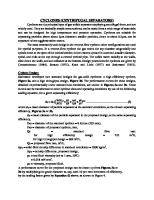Upset Forging Die Design [PDF]
Module-II of PDPT 2.3 UPSET FORGING DIE DESIGN In upset forgings, as a rule, no reduction in cross section occurs and,
24 0 1MB
Papiere empfehlen
![Upset Forging Die Design [PDF]](https://vdoc.tips/img/200x200/upset-forging-die-design.jpg)
- Author / Uploaded
- Chinmay Das
Datei wird geladen, bitte warten...
Zitiervorschau
Module-II of PDPT
2.3 UPSET FORGING DIE DESIGN In upset forgings, as a rule, no reduction in cross section occurs and, therefore, the stock to be chosen is of the smallest area of cross section of the component. Also, very small or negligible flash is provided in upset forgings. Depending on the shape of the upsetting to be done, the number of passes or blows in the die are to be designed. The amount of upsetting to be done in a single stage is limited. To arrive at the safe amount of upsetting in a given pass, the following three rules are to be satisfied to achieve defect free upset forgings. Rule No.1: The maximum length of the unsupported stock that can be gathered or upset in a single pass is not more than three times the stock diameter. Beyond this length, the material is likely to buckle under the axial upset.
Figure 2.3.1: Application of rule one for proper upsetting Rule No.2: If the stock longer than three times the diameter is to be upset in a single blow, then the following conditions should be complied. The die cavity should not be wider than 1.5 times the stock diameter and free length of the stock outside the die should be less than half the stock diameter. When these conditions are not complied, the stock would bend.
Figure 2.3.2: Application of rule two for proper upsetting
Lecture Notes of Chinmay Das
13
Module-II of PDPT Rule No.3: For upsetting the stock which is longer than three times the diameter and free length of stock outside the die is up to 2.5 times the diameter, the following conditions should be satisfied. The metal is to be confined into a conical cavity made in the punch with the mouth diameter not exceeding 1.5 times the stock diameter and the bottom size being 1.25 times the stock diameter. Also, it is necessary that the heading tool recess be not less than two thirds the length of the working stock or not less than working stock minus 2.5 times the stock diameter.
Figure 2.3.3: Application of rule three for proper upsetting The above are the absolute limits for proper upsetting. But in practice it may be possible to cross these absolute limits. Location of Cavities The upset cavities may entirely be kept in the gripper dies or in the heading tool or part in the gripper and part in the heading tool. The choice of location mainly depends on the severity of the upsetting and the convenient location of flash for trimming. Simple forgings requiring smaller upsetting may contain the complete die cavity in the heading tool. Also complex shapes requiring severe upsetting are obtained with the die cavity completely in the gripper die. For very simple shapes, one pass may be enough to obtain the final shape, but majority of forgings require three or more passes. If trimming of flash is included, then an additional pass is required. All these passes are arranged on the die block in an order and the stock is moved from one pass to the other sequentially. While designing the heading tool or the punch to slide into the gripper die, it is necessary to provide clearance between the two such that no seizure takes place due to uneven expansion or due to scales of the punch and die. Figure 2.3.4: Location of cavities This clearance should be of the order of 0.125 to 0.200 mm. The length of gripping portion of the gripper die should be maintained between 3 and 4 times the stock diameter.
Lecture Notes of Chinmay Das
14
Module-II of PDPT
Figure 2.3.5: Gripper die section Stock size, mm 10 16 20 22 25 32 40 45 50 65 75
R, mm A, mm 5 0.05 8 0.06 10 0.08 11 0.09 12.5 0.10 16 0.13 20 0.15 22.5 0.17 25 0.18 32.5 0.19 37.5 0.20 Table –I: Gripper die dimension
C, mm 0.40 0.40 0.40 0.40 0.40 0.80 0.80 0.80 0.80 1.20 1.20
Figure 2.3.6: Upset forging products
Lecture Notes of Chinmay Das
15
Module-II of PDPT Reference: 1. 2. 3.
Manufacturing Technology by P.N.Rao, TMH , page 272 -275 Dies, Moulds and Jigs by V. Vladimirov, MIR Publishers, page 301-304 Manufacturing Engineering and Technology by Kalpakjian and Schmid, Pearson Education, page 353-355
Review Questions 1. 2. 3. 4. 5. 6. 7. 8.
Why lower taper angles are provided in upset forging dies? In which case cavities are made in header tool of upsetting die? The steel bolt is manufactured by which process and how? Why negligible or no flash is provided in upset forging die? Write various materials used for manufacture of forging die. How is stock requirements determined in the case of upset forging? What is the basis for the design of upset forging dies? State various rules. What methods are available to a die designer when the stock length is too long compared to its diameter while upsetting? 9. What are the advantages and limitations of upset forging? 10. Why cold shuts are not observable in upset forging process?
Lecture Notes of Chinmay Das
16









